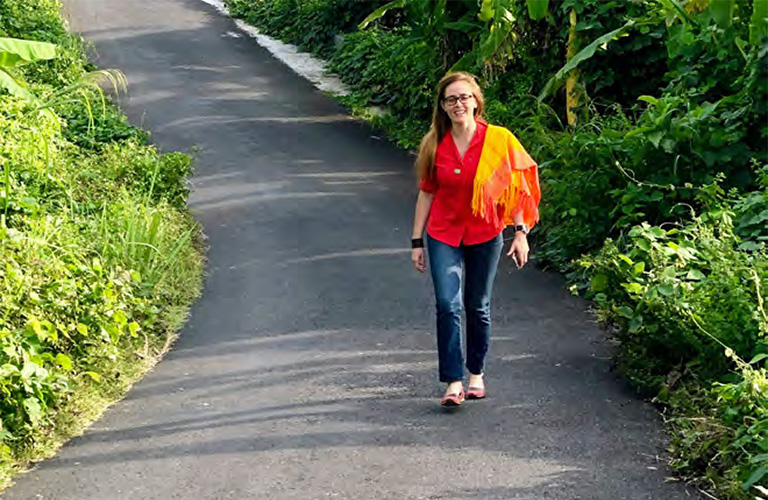Am I okay?

Self-identity, aspirations and expectations of Bangladeshi youth
March 19, 2019
Skilling the world’s youngest continent
March 24, 2019Am I okay?
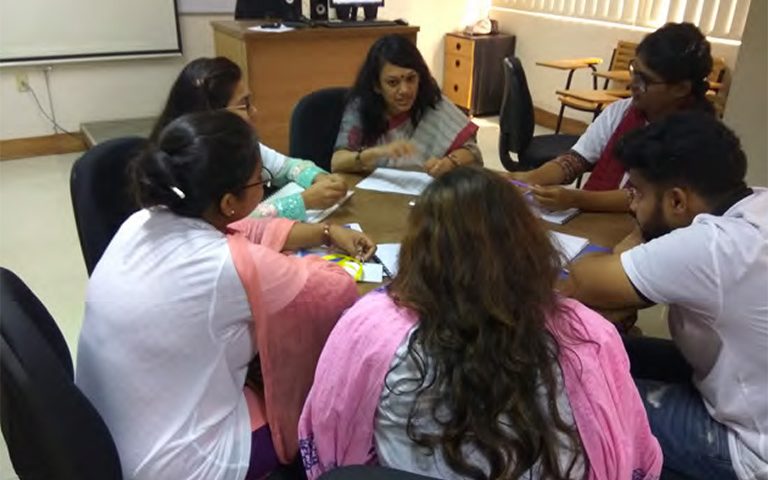
Research-led insights into the provision of sexual and reproductive health information for youth in the digital age
For the fifth of Bangladeshis that arguably need it most, social stigma remains a major barrier to accessing reliable sexual and reproductive health and rights (SRHR) information.
Of the 19 per cent of Bangladeshis estimated by the UN to be aged 15-24, few have access to reliable SRHR information or services because of the shame and stigma attached to discussing these issues with young people, especially if they are unmarried. Inadequate access to SRHR information and services makes young population highly vulnerable to health risks and discriminatory treatment.
Young people often enter their reproductive years poorly informed about their own bodies, health and wellbeing.
The stigmatisation of sex and sexuality obstructs effective SRHR communication and compels young Bangladeshis to seek information elsewhere.
Increasingly the source of this information is the internet.
Online sites offer a wide range of ways for young people to acquire SRHR information. Unlike other sources of health information, the internet offers portability, anonymity, the opportunity to formulate questions and seek personalised responses, and the ability to interact with peers who are not local and not connected through face-to-face networks.
While the internet has resulted in an explosion of sources of SRHR information, they are usually outside formal government health and education domains.
The Centre of Excellence for Gender, Sexual and Reproductive Health and Rights (CGSRHR) at the James P Grant School of Public Health, BRAC University, in collaboration with the Amsterdam Institute of Social Science Research, University of Amsterdam, recently conducted a study titled Digital Sister for Urban Youth to assess the sexual and reproductive health and rights information and service needs of urban Bangladeshis aged 15-24.
Financial support for the study was provided by NWO, the Netherlands Organisation for Scientific Research.
The objective was to explore the use of online platforms by Bangladeshi urban youth seeking SRHR information. The study looked at the types of SRHR information that urban Bangladeshi youth sought, and the platforms they used to obtain that information.
Researchers conducted focus group discussions with over 200 young men and women (aged 15-24) from 11 universities, schools and youth-based organisations in Dhaka and Chittagong. In addition, researchers analysed 1,000 questions about SRHR issues posted on Maya Apa, the online anonymous messaging platform.
The study found that young people use a variety of digital media as sources of SRHR information.
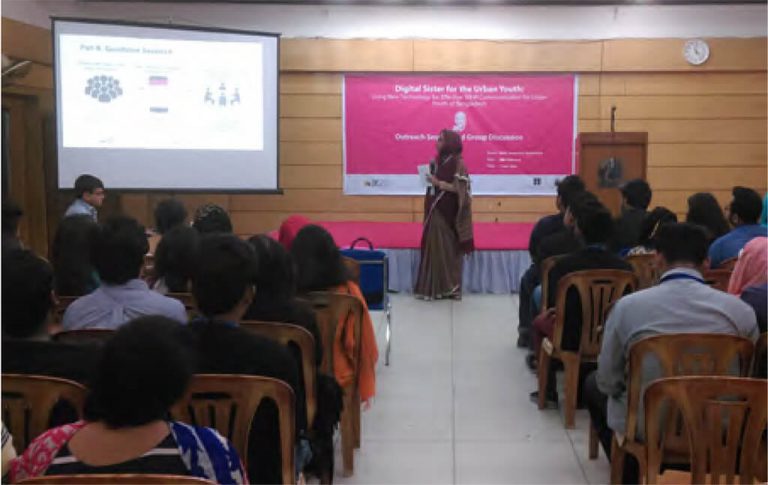
Search engines like Google, social networking sites like Facebook and video-sharing sites like YouTube were popular sources of both information and networking with peers and the outside world.
Young people were more comfortable obtaining SRHR information online – and on their own – than with discussing these topics openly. Privacy and anonymity were important considerations. The advantages of accessibility and availability were also important – digital platforms provided ease of access from any device, anywhere, and searches resulted in an abundance of readily available information.
Respondents said that they were allowed to use digital devices – laptops, desktops and smartphones – and the internet for educational purposes. They said there were neither gatekeepers nor guards to monitor their activities on digital media. This made searches for sensitive topics like sex and sexuality simple.
One 22-year-old woman said, “I turn to Google because I can hide my identity there.”
Another reason for preferring online platforms over personal interaction was the fear of judgment from those they sought advice or information from.
Respondents told researchers that young people asking questions about sex or sexuality were often regarded as morally bad.
The anonymity of online interaction helped them to preserve the social image of being ‘a good person.’
One young woman said, “We still live in a society where this [SRHR issues] is taboo. I won’t let someone judge me for asking a question. Anonymity is very important to me.”
A lack of access to other available sources has meant that pornography also plays a vital role in disseminating information about sex and sexuality for this age group.
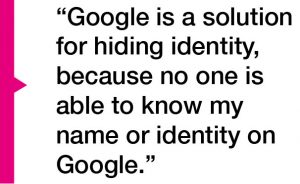
Young people, mostly males, sought out pornography out of curiosity. Male participants reported that men of their age group were attracted to watching pornography and thought this may have negative consequences on their health.
Social and cultural restrictions on accessing sexuality-related information or even discussing such issues were important drivers for seeking information elsewhere.
The study found that people in this age group were mostly interested in learning about their bodies, sex, sexuality and sexual performance.
“We are still in a society where this is (SRH issues) a taboo. I would not let someone to judge me for what I am asking.”
They were very interested in finding solutions to their personal SRHR-related problems and concerns.
An analysis of online messaging platform queries found that young people asked questions as basic as “What is sex?” to very personal queries about genital size and body shape.
Male health questions were mostly related to sexual performance, masturbation, the size and shape of the genital organ, premature ejaculation and erectile dysfunction.
Female health questions focused on menstruation, including late or irregular periods and abdominal pain during menstruation, and on emergency contraception and family planning.
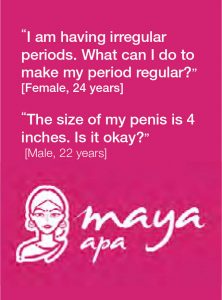
Some examples of questions asked on
Maya Apa are:
During group discussion, many girls reported facing problems regarding irregular or late periods and abdominal pain during periods.
Some reported feelings of shame about their bodies related to pubertal changes and vaginal discharge.
Most males frequently mentioned masturbation and wet dreams, and expressed concerns about the negative impact of this on their health.
Sex, sexuality and STDs/STIs were common areas of interest among both young men and women, although men reported this more. Respondents said people of their age group were very curious about sex and sexuality.
Sex and sexuality-related information covers a range of issues including sexual orientation, sexual intercourse and performance, and the relationship between sex and pregnancy.
Male respondents said pornography was a popular source of information about sex and sexuality in their age group, followed by YouTube videos and closed Facebook pages.
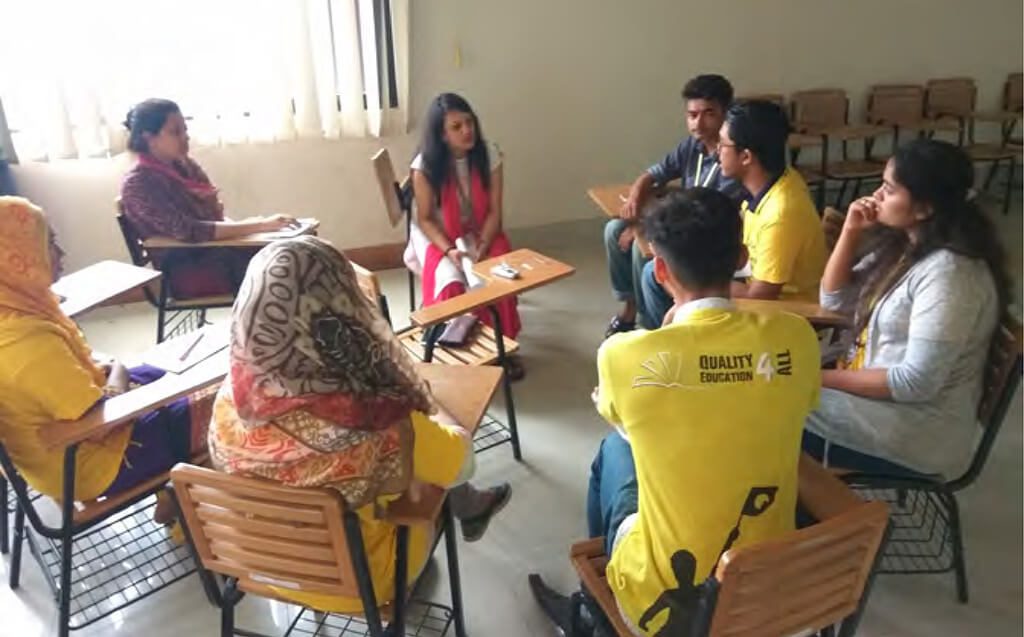
Female respondents reported that young women of their age group mostly searched for menstrual health issues, especially for ways of making irregular periods regular. Some adolescent girls said that after menarche they searched online for medicine to stop menstruation. During group discussion, young women shared about their experiences of sexual harassment in daily life. Almost all female participants said that women of their age were worried about sexual harassment. Male participants said that young men were also victims of sexual harassment, mostly in public places and by older men. They reported several forms of sexual harassment, including male-to-male, female-to-male, and harassment by transgender people.
Both male and female respondents said that people of their age were also concerned about romantic relationships. Female respondents said young women in romantic relationships most often faced pressure from their partners to have sexual relations.
Young people want to receive SRHR information in a private and discrete manner that keeps their identity anonymous. They want a trustworthy medium where they can share their personal queries and opinions while maintaining privacy. This is one of the main reasons why they rely on cyberspace more than on their close friends and relatives.
They acknowledge that online platforms were not always accurate.
Despite the drawbacks, they still consider it an open space and a source of information that is not available elsewhere.
Bachera Aktar is a senior coordinator and Pushpita Ray is a senior research assistant at the James P Grant School of Public Health, BRAC University.

